So, I’m back in Maine on my mission to finally make a knife from raw materials. (Cue the caveat about making anything from scratch requires inventing the universe…) Unlike the Beginner Blacksmithing class, there were only two students in this session. Both of us had previously taken other classes, so we knew a thing or two. The other student brought a billet of twist Damascus he made in an earlier class. I was working on the provided 1084 steel. One of the first things mentioned was that 10-series steel is basic carbon steel with no other elements intentionally included. The last two digits being how many hundredths of a percent of the material is carbon. So theoretically, 1084 is 0.84% carbon and 99.16% iron. Of course, there will always be some contaminants and impurities, but these were not enough for us to worry about.
Unlike Beginner Blacksmithing, we only used the propane forge for the heating in this class. As there were only two students, we only lit one forge. There was enough space for both billets. The first operation was straightforward – take down the corners and begin tapering the tip of the blade. This gave me flashbacks to the last class when I had trouble setting tapers… but I had no similar issues this time. I’d learned my lessons there.
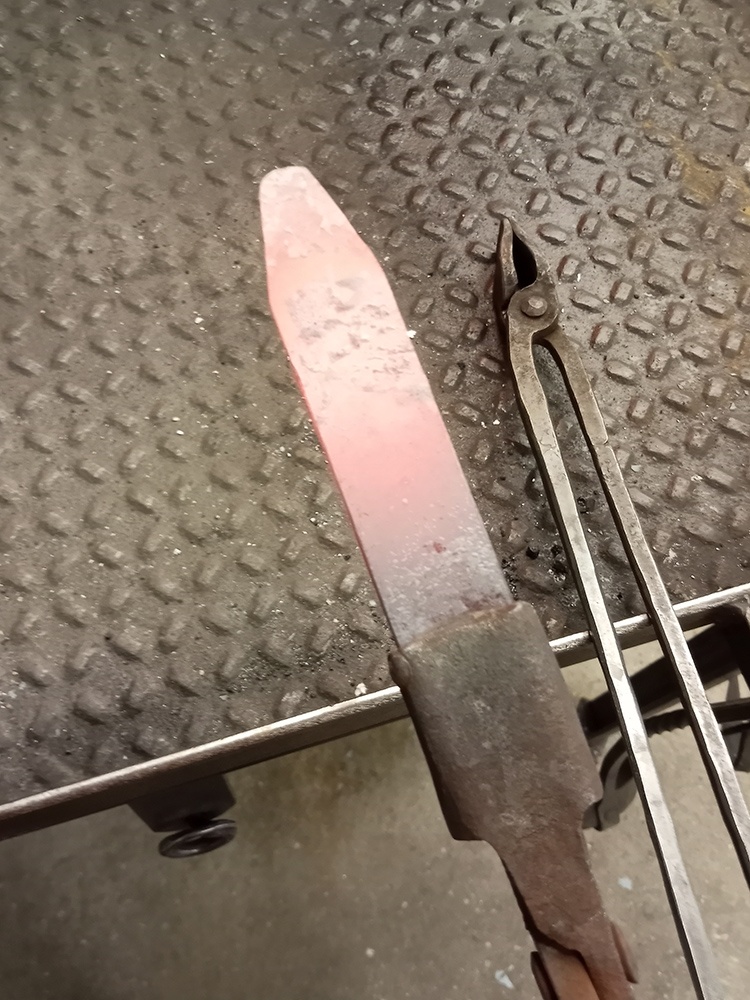
That red hot is too cold for forging, so it’s going back in the forge
Continuing on making the basic shape, we needed to set a shoulder at the base of the blade and continue the rough preform. One thing to remember is that when you strike hot steel, the displaced material will move towards all of the edges of the hammer. And working flat stock on the edge means each hit thickens the work piece. We don’t want that, as the flat stock started out thicker than the knife needs to be. So every other heat or so, it is important to go over the flat face to narrow the steel back down again. Though a combination of edge on and flat on hammer strikes, you will give the steel no option but to move in the direction you’re trying to coax it. Eventually, we did set a shoulder to define the base of our blade section. For anyone who missed the last article, a shoulder in steel is just an interior angle made by hitting the steel when its on the corner of the anvil. It has a couple of uses, including providing a place to lock the work piece against the edge of the anvil and help keep it from moving as you hammer.
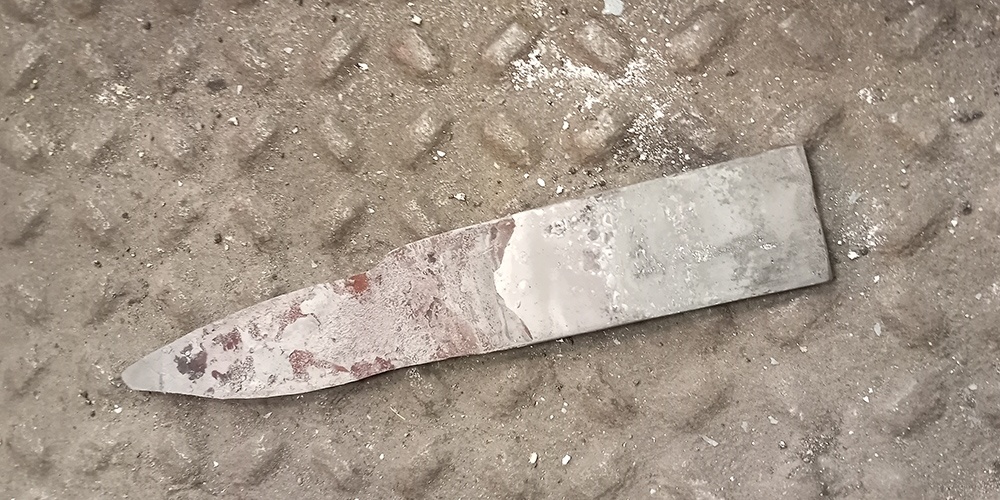
It’s taking shape, but still has work to do
With the blade end crudely roughed out, we turned our attention to the tang. This starts with setting another shoulder at least twice as deep as the one we did for the blade. Why? Because the handle is going to be narrower than the blade at the ricasso (the unsharpened part just before the grip). This started a general flare on the tang that we then set out to exaggerate by spreading the end of it. Spreading was another operation I hated. A standard blacksmithing hammer has a square face on one side and a narrow, rectangular face on the other. This narrow face is called the cross-peen. It is used for this operation because while steel does move in all directions when struck, it moves more along the path of least resistance. The narrow profile of the face means it moves more along the shortest path to the edge. This pushes the steel mostly in two directions, away from the long edge of the face. A series of precise strikes will keep it moving in those directions, thinning out and widening the piece a lot faster than is possible with the square face. Mostly we wanted to create a flare and bevel the tang along its long axis from the ricasso to the end. I don’t know the reason why he wanted this bevel, he didn’t given an explanation on the why. But, I did as instructed, and got the basic preform completed.
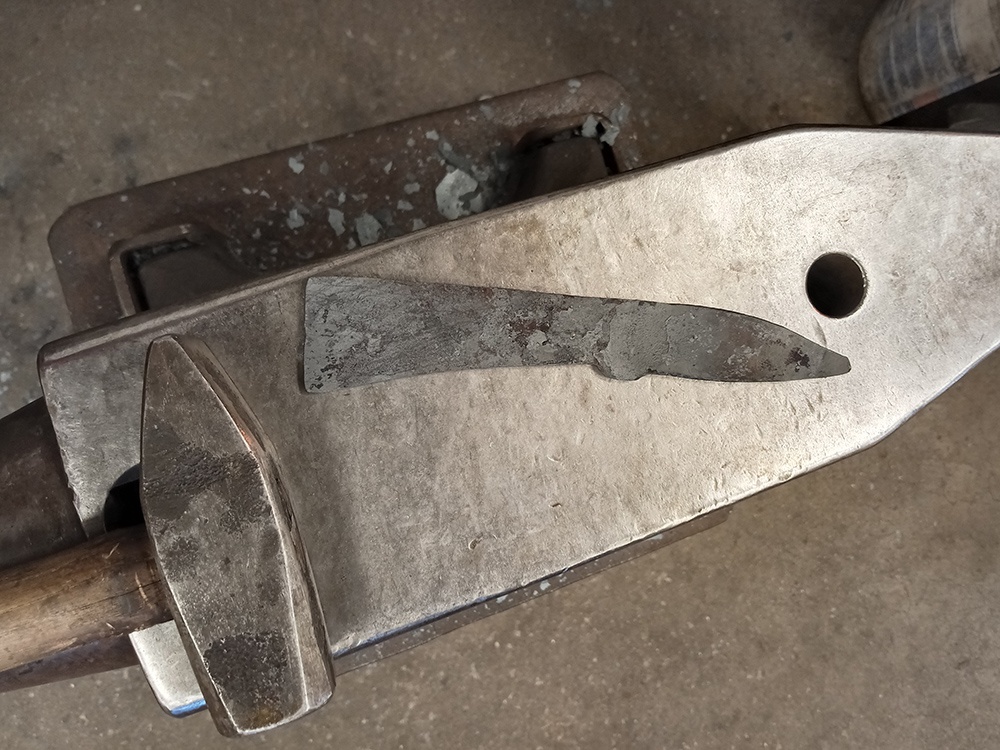
It’s starting to look a lot like a knife blank.
Now, the problem with that blank is simple – the blade is still of uniform thickness. It’s fairly obvious to anyone who looks at a knife that it has a wedge shape from edge to spine. Rather than grind in all of that bevel and waste all that material, we got it started by hammering it in. There is a caveat. It’s that part I mentioned before about steel moving in all directions when struck. If I just started putting that bevel in as it stands, the blade would bend back like an inside-out sickle. To avoid that nonsense, we pre-bent it forward, so putting the bevel in would straighten the blade. I even got a picture of it with the steel still glowing. Though that threw off the camera a bit.
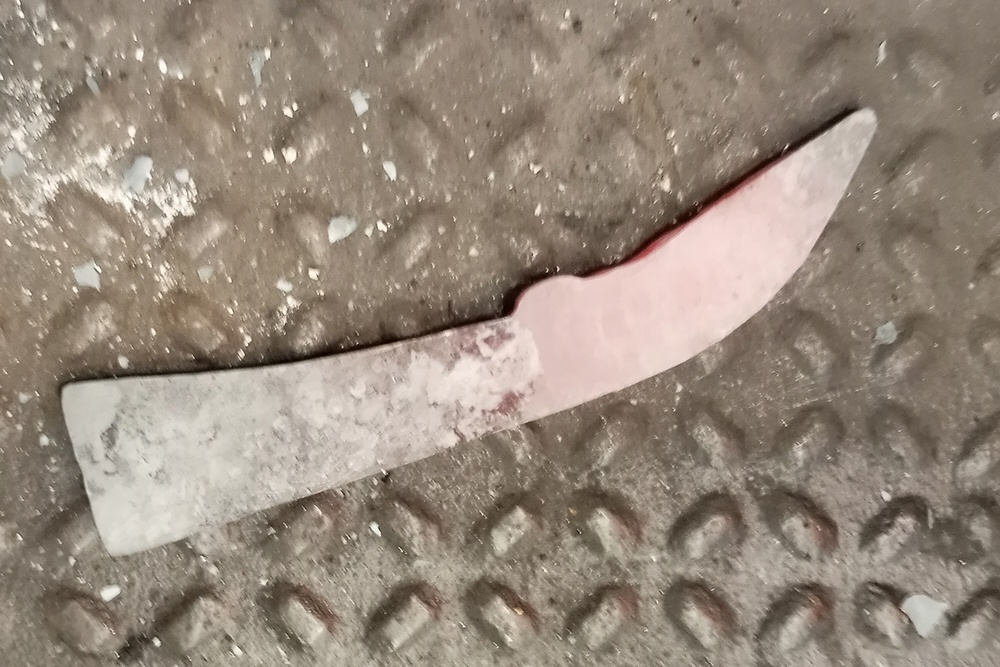
I debated hooking it further, but didn’t need it.
To hammer in the bevel is simple, you just need to keep the hammer face at a consistent angle off true while striking the steel. Oh, and matching that angle the other way when you flip the work piece to get the other side and keep the edge centered. Though at this point, it was an operation I was more than comfortable with. A bevel is just another form of taper. Anyway, putting the bevel in was the last hammering operation we were going to do. It was far from the last heating operation we were going to do. The first thing we had to do was normalize the metal. All this heating and hammering had grown the grain structure and work-hardened the steel. So we needed to undo that through a process called thermocycling.
I’m unclear on exactly why the process does what it does, but I can repeat how we achieved it. In short we heated the metal to successively cooler temperatures and let it cook to black in between. The important part of this operation was making sure that the heat was evenly distributed while not letting any area get too hot. Because we had a complex shape, there were plenty of spots that heated up faster, and proximity to the burner inside the forge also contributed to the uneven heating. So even during the heating, we pulled the blades out of the forge to let the heat spread though the metal several times. Once we reached our target color, we would rest the blade spine-down in the cold coals from the coal forge to cool to black. Why the coals? Because the options for setting it down were the metal anvil, the metal table, or the porous carbon coals. Of these, the coals (actually coke and ash) were the least conductive of heat, so it cooled slowly there. Having the heat quickly sucked out by, say, the highly conductive thermal mass of the anvil, would not produce the desired changes in the steel’s structure. Once cooled to black, we would repeat the heat to the next cooler color in the sequence. We went first to dull orange, then bright red, and last to barely glowing. Then we let it go to room temperature.
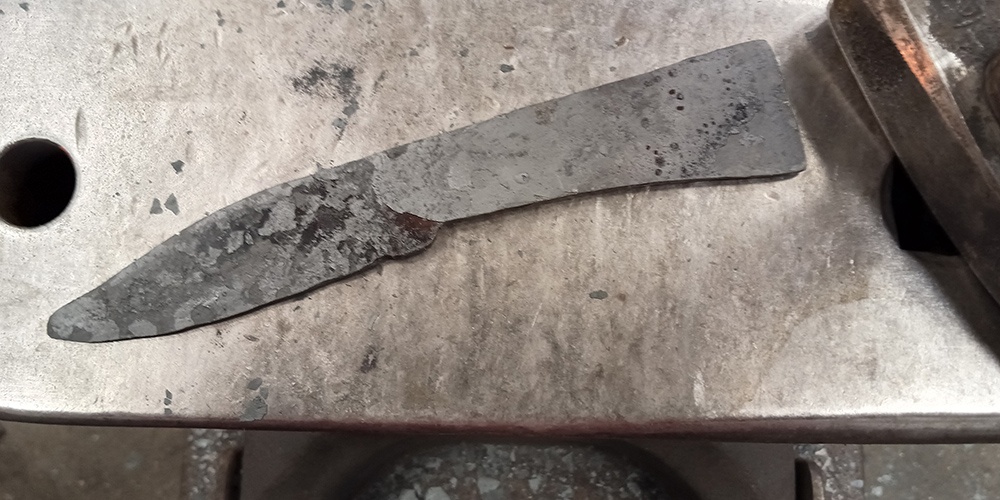
It’s still blunt
Once the thermocycling was done, we shut off the forge. We were not done with heat, but we were done with the forge. We went into the next room where all the expensive grinders were set up and went back to kindergarten. Actually, we were planning the profile of the knives. To do that, we traced the blank we’d forged onto scrap paper, then sketched out potential shapes for the blade and handle. Once we found one we liked, we cut it out and glued it to the side of the steel with spray adhesive. Funnily enough, despite all the high quality metalworking machinery, the box of art supplies lacked a pencil sharpener. So the instructor made use of the “Three-thousand dollar pencil sharpener”, aka, a belt grinder.
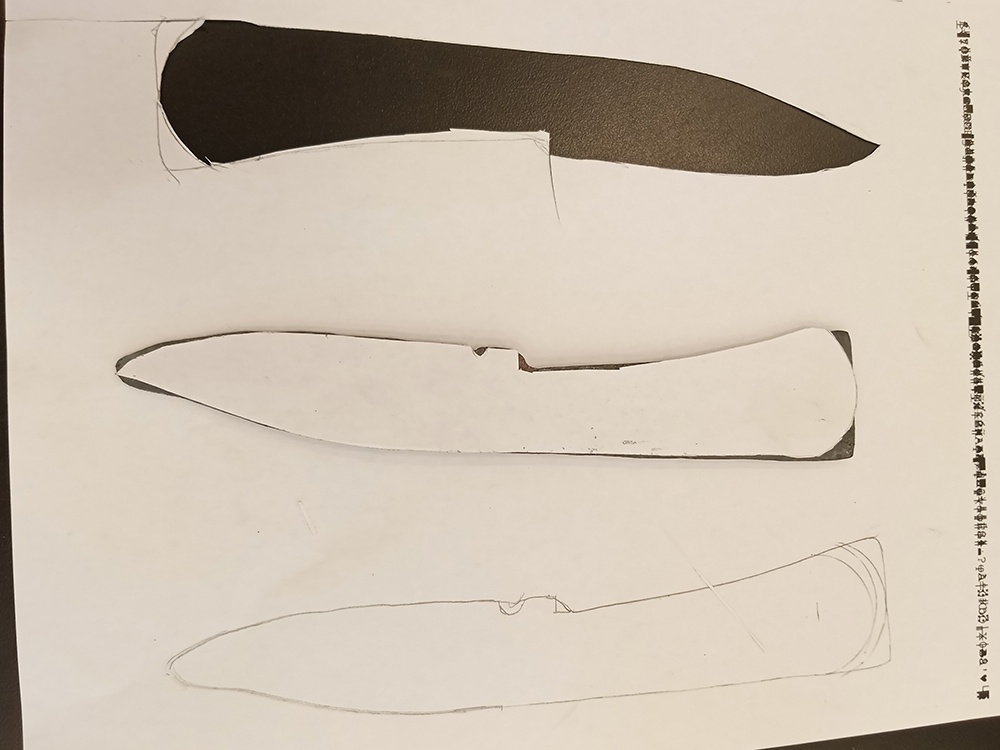
Just pencilling it in.
At this point, it was time for the students to start grinding. The goal was to make the shape of the steel approximate what had been planned out on the paper. There were two areas we were using for this operation. One was the flat region with a backing plate behind it called the platen. The other were the wheels at either end of this called the platen wheels. The only other region on the belt we would touch would be the slack, that is, the unsupported span between wheels where the belt has more give. We wouldn’t touch the slack until the very end when we put the sharp edge on. So, I used the three thousand dollar pencil sharpener to grind out the profile, aiming for a fairly classic clip-pointed shape.
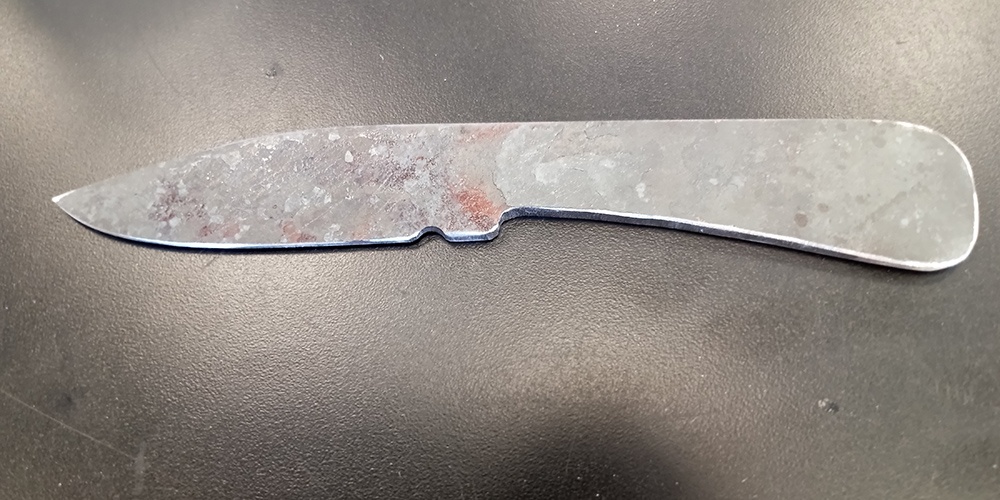
I have finalized the shape. Get used to that profile.
Once the profile was in, we had another long grinding operation. This is flattening the tang. It was already pretty flat, but hand-hammering will leave a fairly uneven surface. To best fit the handle scales on, we needed something smoother. A continuous plane from ricasso to end was what was needed on both sides. This took a while, especially for the other student, as his blank was beefier to better preserve the pattern. Thankfully, we had magnets to hold the steel with, as it would be impossible to bare-hand this operation. We’d lose our fingers even trying. Once both faces of the tang were smooth and free of forge scale (the tell-tale sign we’d taken out the deepest of the hammer marks) it was time to drill the pin holes. We’re doing it now because the metal is the softest it will be while having the knife shape, and drilling hardened steel is a pain in the bits.
The drilling station is a place where a larger class would bottleneck. There are only three drill presses in the room. Since there were three operations to be done, they were each set up with the appropriate cutting steel for one and we moved the work from press to press. With only two of us, we never ran into any contention for the drill presses. If the class were full, there’d be a line stuck waiting to get into sequence. Anyway, before the first cut, we had to site the pin holes. We did this first with a caliper and a sharpie to mark where we wanted to drill, then a center punch to give the drill a place to bite into exactly where we told it to. With the center punch’s guide marks, we drilled the initial holes, then moved to the next press. There, a half inch drill was set up. We were not pushing that all the way through the steel, but instead using the conical tip to chamfer the edges of the pin holes. Last, there was a reamer set up to clean out the holes and remove any burrs the chamfer operation left inside.
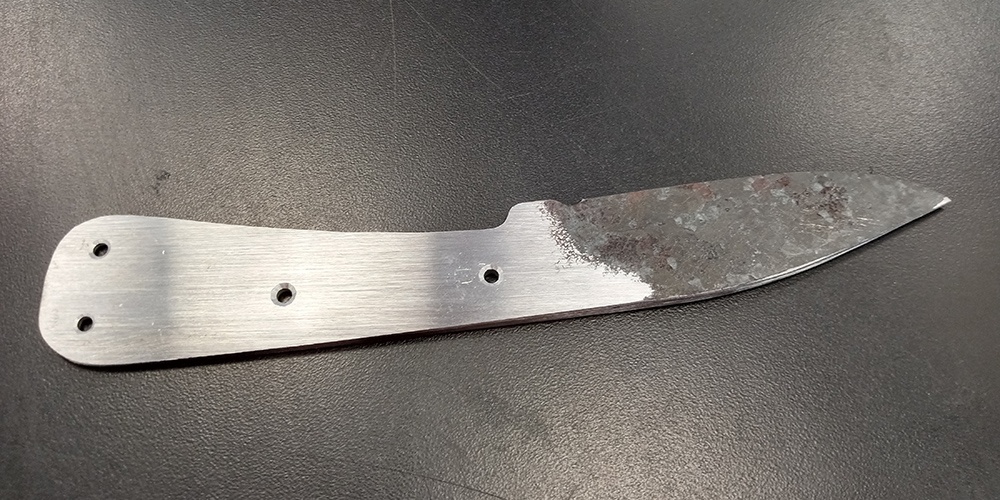
A lot of prep work goes into making the later steps easier.
So, we were now ready to heat treat. The instructor set the heat treating kiln to fifteen hundred degrees and while it was warming up, we picked out handle material. I spotted immediately a brick of black walnut that I knew I wanted. The instructor was surprised that it was still there. But it had to be cut into scales. First it was split lengthwise on a band saw, then I took it to the pencil sharpener to thin down the halves to a more appropriate size. It was at this point that I suffered my only injury in this class. I did burn myself three or four separate times during Beginner Blacksmithing, each one a testament to stupidity. Hot metal is hot. This time, it was an accident. The first knuckle of the middle finger on my right hand brushed the belt. Now, the grinder belt has at this point gleefully removed steel and wood without difficulty. It cared not a whit that it had come in contact with human flesh. Thankfully, the contact was slight, and I pulled back quickly. It only took off the outermost layer of skin on a patch less than three-eighths of an inch across. While it wasn’t severe and barely even bled, I decided to work on something else for a moment.
Thankfully, it came time to load up the kiln and bake our blades. There was what looked to be a ceramic rack in there where we placed our steel in a neat row, two spaces apart. Because the kiln is small and the temperature differential is so great, each time the door opens, the temperature inside drops rapidly. So loading and unloading had to be done as quickly as possible without getting sloppy. We only needed to bake for five minutes, so in this time, the instructor took the lid off the quench tank and started up the ventilation to draw off any smoke generated. Thankfully, the actual quenching was not dramatic. While it had to be done quickly, and coordinated between the person whose blade was going in the oil and the people operating the kiln door, we avoided any flare-ups. So, no photogenic fireballs, and no burnt students.
The last operation of the day was tempering. Once cooled post-quench, we put the blades into a toaster oven a four hundred and fifteen degrees for two hours. Yes, it was an ordinary, run of the mill consumer toaster oven as found in any appliance section. Since we put it in at five in the evening and class was over for the day, my last picture is actually the first picture of day two – the knife post tempering, along with my handle scales.
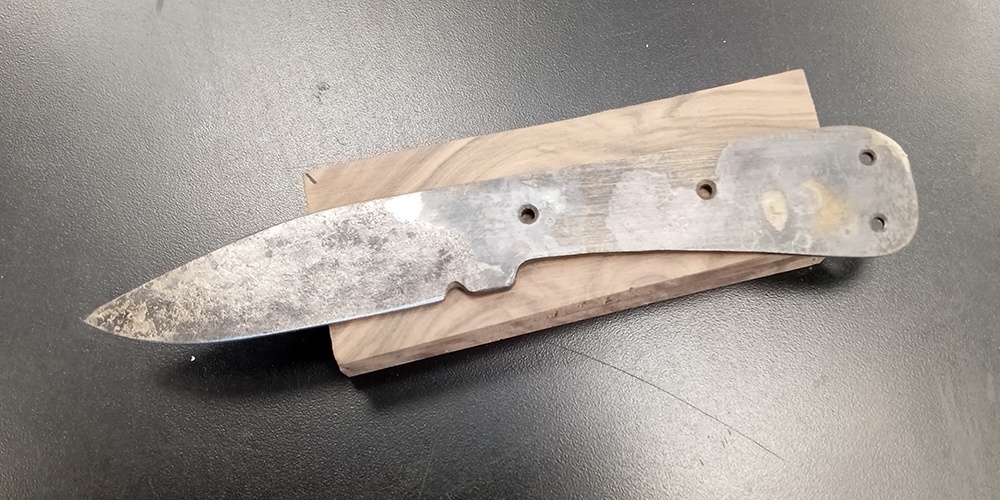
This is technically a day 2 picture. I couldn’t get a shot of it in the toaster oven.
Continued on Day 2

So far I’ve found
threefour categories of anvils available on the market.1: Properly drop forged and heat treated german made anvils that cost as much as a new rifle, but they have the european triangular heel.
2: US made cast anvils that are properly heat treated but are not as tough, cost half as much and have the american squared heel.
3: Cheap chinese crap made from un-heat treatable cast iron where your hammering will simply dent and divot the anvil face.
4: Really weird alternative anvils which lack the basic functionality of honr, heel, and hardy – Price and metallurgy varies.
In terms of a forge, I’ve found options that are essentially the same as my plans for a scratch built one, and in a similar rpice range, but made by someone who knows what they’re doing. If I were to do a portable setup where I’d drag the anvil, forge, etc, out to an otherwise empty lot, I’d need some sort of stand to hold up each of those items that ideally could be broken down and packed in the back of the car.
I’m thinking an old grill trolley would work for the forge (and would hold the propane tank without modification). The anvil stand would need to be more robust given the dead weight and the shocks it would have to take. There are commercially available options – If I’m willing to spend as much as a forge on just a stand. The anvil stands at the school were just segments of a log.
The hardest part about all this is finding a spot where I can set up shop and not have the neighbors hassle me over the noise. The options on location I’ve mustered up are either too expensive, in dense residential areas, or both. I’ve spotted a $49K plot of land whose neighbor is a construction yard, maybe. The problem is I can’t narrow down the exact location of the lot since the features in the phogoraphs from the listing that are pretty distinctive (ie, a hydrant, a freestanding gate, etc) don’t appear on the streetview of where the map asserts the plot is. Finding the landmarks from the images puts the plot even further from any neighbors, so I’m liking it… I’m just debating if I want to take out a mortgage when I’m so close to being out of debt.
Have you looked at the used market for anvils? I don’t think it’s much cheaper, but it’s my understanding the the quality higher (if you do your homework).
Should read: “the quality is higher”
I’ve made a few searches, but a lot of used anvils are in the same price range as new anvils. Though I’ll follow a good lead if anyone stumbles onto one.
Oh, for reference, the anvil you can see in This picture> is the european style, the anvil in This one is the american style.
Tag fail… at least the links appear to work.
Great article
Thank you.
Fortunately, my hobbies are limited to making booze, wood working, and archery all of which I can do at my rural home.
INSURRECTIONIST!!!
Right here, he’s making clandestine weapons that will totes win the day over the RMCP
‘I’m unclear on exactly why the process does what it does,’
So, steel forms irregular grains when cooled from melting. When you hammer it, these grains lock against each other and it gets harder and harder to deform the metal.
When you reheat the steel you’re dissolving the grains and releasing the internal tension between grains that you had created.
I See.
I condensed a whole college course into 3 lines, so there is a lot more to it, including different types of steel, (austenitic, etc.), dislocations, etc.
Great read. Thanks!
You’re welcome.
I spotted immediately a brick of black walnut that I knew I wanted.
Excellent choice. I think walnut, especially with a good oil finish, is gorgeous.
Oh, it is.
Very dark, but when you look at the wood the grain is there. There are plenty of pictures next week that show how it turned out. Though I still had a few oil coats after the last picture before it was done.
There are plenty of pictures next week that show how it turned out.
Oooo… nice
I might be in PA next weekend. But I’ll read all the weekend threads once I get back if I go on the trip.
That wood looks like it will turn out nice.
Thanks UCS. Timely. I watched this last night and thought of you. It really shows how the hammered metal is displaced
https://youtu.be/AgpGXSAS7Cs
I’m old enough that i got to take metal shop in jr high and we did some forge work. First thing the grizzled shop teacher said was “don’t strike the anvil directly! It will shatter.” Of course, some ‘chuke in the class had to do just that while I was hammering. I carried a small piece of anvil schrapnel in my arm for years.
Acres of forge scale falling off that thing…
And that sounds like your school got cheap anvils. Our smithing instructor demonstrated rebound on the anvil face proper. Or was your classmate abnormally strong?
He hit it on the edge pretty hard. There were a lot of chips off of it.
That screams poor heat treat. We do a lot of operations on the edge, and I’ve missed the work piece often enough.
Wait, have you got a pair of stabbing gloves yet?
[Answer Redacted]
All your schools are belong to me.
/Gov. Rached (NY-Wicked Witch)
I am so done with this place.
That’s maddening.
Really interesting, UCS. I’m always surprised when I learn that there are people (like your instructor) that have these old style skills. The demand has certainly shrunk over the past couple centuries.
How did your arm hold up to the hammering part? Do you still have some of the build up left over from your earlier schooling?
Thanks, good pictures that included us in the process.
My arm did just fine, there was hardly any hammering.
I need to do more reverse curls though. If only to build up endurance some more.
Great article! Looking forward to the next one. Have you tried antique stores for anvils? Oddly here in DFW those and other metalwork tools turn up in antique stores. Not little ones, either. Big farmhouse ones.
I was thinking of it once I was sure I wouldn’t be hassled over my uncovered mug.
I wonder if I should bring a hammer to test the rebound.
Do you have farm auctions nearby?
I had or have a piece of railroad track in the garage at the cabin. I’ll look when the snow disappears. You would be welcome to it if you could use it. The previous property owner was a welder and probably used it as an anvil.
If it was in use on an actual railway once upon a time it’s probably been hardened sufficiently to be an anvil. I definately could use that.
I don’t know about farm auctions, I’ve not looked.
Farm auctions can be a very good place to find blacksmithing tools.
I’m just not sure how many are left in this area.
Actually… Around Saratoga there should have been plenty of ferriers over the years (race track lives there), so there might be.
I don’t know how things are in your area, but here you’ll see old blacksmith tools come up that have been sitting around, unused, for decades. The following generations hung on to it because they had room in the corner for great-grandpa’s old stuff, but the day finally comes to clean out the shop, or retire, and on the auction it goes.
My farrier realization is probably where a lot of the tools will come from around here. A quick search found a dozen or more currently active. And the track’s been a fixture for ages.
Yes, with that kind of horse racing/raising action in the area, there should be no shortage of old anvils being bought and sold.
Jimmy Diresta (https://www.youtube.com/watch?v=PWZULDm5s0s) is somewhat in your area. He seems to have no problems finding anvils. He goes to a lot of flea markets.
Block of wood like that probably costs more than an anvil these days.
I love that guys videos.
Remind me about the 1st of April, to look for it. I know where it’s at but too much snow for a few more weeks.
The auction bills (the advertisements) would certainly list an anvil, if they have one. See if you can get on the mailing list for the local auction houses.
Got it.
He’s trying to get you to come out to Honey Harvest.
Well, I haven’t planned any vacations for the remainder of the year yet.
April Fool’s!
Good call. I have a couple laying around. Chunks of used rail are popular as poor-man’s anvils. Probably because nearly everyone in the country can likely find some for sale within a few hours drive of home.
Here’s a joke for you:
An Englishman, a German, and an Irishman walk into a bar and all three order pints of Guinness. A fly lands in each of their beers.
The Englishman demands a fresh beer, while the German simply flicks the fly out.
The Irishman picks up the fly and holds it over the beer and yells, “Spit it out, spit it out, you bastard!”
I laughed. And laughed. Thanks, Ron.
Someone is easily amused.
And someone has no sense of humor.
That would explain why Swiss constantly narrows his gaze.
That’s what my wife says about me when she rolls her eyes at my jokes.
But in my heart, I know I’m funny.
I always heard Scotsman. “Spet it oot, ya wee bastard!”
Well played United. Got to the airport on time. Our plane is at the gate and the weather is clear – nothing could go wrong. But no flight attendants yet…
Covid killed them.
I’d be willing to pass around drinks and tell people to fasten up myself.
Are you willing to sleep with the pilot?
That’s a perk,not a punishment, right?
I saw that movie.
Otto Pilot
I was thinking of a porno but that works too.
One of my company’s Directors (adjacent to boss-boss) with whom I am going to be working on a big project that came out of the fact that Europe doesn’t want to do business with the US anymore mentioned that “we” are flying to London in June. I sure hope that wasn’t including me but was referring to his boss – kind of hard to tell on a Teams chat.
No way do I want to fly in current year. Plus I have no idea if the UK is quarantining the unblessed.
Well, regardless, let’s hope that by June the COVID theater has gone away world-wide.
Honestly I have no idea – so many conflicting signs. Loosening the tryanny in some regards, tightening the screws in others.
Just keeping us on our toes.
The UK is dropping most covid measures. You may have less of a problem over there. Getting back into the US on the other hand….
I want nothing to do with any of it. I am so fucking over all of this, and I doubt it will be “over” by the summer.
Looks nice, thanks for this.
You’re welcome. The next part is a week from now.
From right now?
Plus or minus two hours.
Did forged in Fire have anything to do with your desire to learn this?
He wanted to burn down the rest of Cohoes.
I remember that.
Right after that is when the show added it’s “Forging is Dangerous” Disclaimer.
Yeah, local TV for UCS and me is Albany, so that fire was a big deal.
Albany region. It fits.
I had a heck of a commute that evening because they ended up shutting down a bunch of roads along an axis I needed to cross.
Here’s some music to burn the village by:
Makes me proud to be Mongolian.
The interest began earlier, but I can’t say it wasn’t a contributing factor in recent years.
Glibs After Dark.
https://archive.md/rQDuU
NSFW.
I think there are a few in there that are too young to be in this type of gallery. I stopped scrolling part way through because of that.
Number 1 missing her right arm was enough for me.
Still would.
Some of you are prudes. Too good to masturbate to an underage amputee or something?
Excellent article, UCS. Thanks for letting me live vicariously through you.
Thank you and you’re welcome.
desired changes in the steel’s structure
My favorite uncle is a farrier, and I worked with him some four decades ago. One of my favorite experiences shared with him was taking him to the forge years later at metalmuseum.org.
Uncle learned the old way and can tell you the temp by the shade within 100F. I learned in engineering school: media.cheggcdn.com/media%2F4a9%2F4a9713ae-812d-4ddd-a723-246d0214ee0d%2Fphpx3yR8S.png
Designing for microstructure was always derivative, two examples of which many of you will know. If a connecting rod is too strong, its failure mode will be brittle failure, breaking and literally blowing out the side of an engine block, destroying everything; if a less strength is selected, the failure mode will be bending, and the block can often be saved and rebuilt. In internal prosthetics, too strong is unhealthy; in a total hip replacement, the shaft inserted into the distal end of the femur must match the stress/strain yield rate of the surrounding bone because if it’s too strong, it takes too much of the load; bone, like muscle, needs to be loaded to stay strong and vital….if the THR takes too much of the load, the bone withers and the prosthetic eventually topples out of the weakened structure….catastrophic.
Favorite line I overheard from another student at the beginner blacksmithing course – “I used to think red hot was really hot, now it’s really cold.”
Thanks for explaining in greater detail some of the terminology and processes frequently mentioned in passing during episodes of FiF, plus describing more fully exactly how that metal is moving as you’re fighting to make it bend to your will. Even more than any of the “maker” activities I’ve tried, it looks as if you’d swear your material had a mind of its own, even though you know it’s just obeying the laws of physics.
That is way cool:; thanks for sharing!!
I was annoyed that I didn’t get a chance to take Materials Science until my senior year of engineering. If I had taken it as a sophomore, my educational path might have been very different.
As it is, I still gravitate to material property and first principles physics in my electrical engineering career.
Atomic and crystalline structures and what makes them what they are ..: mind boggling.
You’re welcome. I’m trying to share what knowledge I acquired in the class (or which I had that is relvant to the class) since handing all the glibs a hammer and telling them to get moving steel isn’t going to be viable.
I was a framing carpenter for many years, but driving nails and moving metal are probably two different techniques.
Well, accuracy is important for both.
I’d say that UCS should take some Firsting classes before he worries about things like metallurgy, but that would be a waste of time. He aint ever going to learn to First like me.
https://www.wweek.com/news/city/2022/02/11/portland-mayoral-aide-outlined-ideas-to-eliminate-unsanctioned-camping-across-city/
It’s a final solution to homelessness.
“campers”
?
Is that real?
Gets harder to tell every day.
It’s a real memo, by a former disgraced mayor and now rehabilitated aide to the current mayor.
If these his ideas when rehabilitated, what was he like before?
https://en.m.wikipedia.org/wiki/Sam_Adams_(Oregon_politician)
Another carpetbagger politician. He was awful as a mayor but that didn’t take him down. Grooming a 17 year old for post-18 relationship and lying about it ended his re-election bid.
It’s interesting that’s where Portland drew the line.
Wow
Those unarmed NGers will really provide a lot of security for 1000 bums packed together.
The homeless guy I knew wouldn’t go near a shelter – said they were too dangerous. This is a guy with 30some assault convictions (he drank and got in a lot of fights).
Deblasio had the brilliant idea of packing them into empty hotels.
It went exactly as you can imagine.
No wonder I couldn’t get a room at the Waldorf.
My youngest turned 16 today. She went out to dinner with her friends. They are now back at the house. Would I be wrong to sit in the kitchen cleaning my shotgun?
Is it a sawed off shotgun?
Cliched.
Do you have any large game to break down into primals?
I could breakdown a head of lettuce.
/vegetarian
Displaying your skills with a chef’s knife may suffice.
I like the way you think.
Yes.
You raised her. She’s fine.
She’s fine. I just want a group of loud teenagers out of my house.
My house is quiet and I hate it.
Point taken.
So you want Chafed to send the teens over to your house.
So, what I’ve learned from these is that metal working is magic.
I’ve made/built/machined a lot of shit, but this is so far out of my wheelhouse that I’m probably gonna obsess over it until I try it.
Bastard.
You’re welcome.
It took me years to finally just do it.
Unless CNN+ is a money laundering operation, I have no idea how they are going to make any money.
https://twitchy.com/brettt-3136/2022/02/10/cnn-hires-on-jemele-hill-who-credited-glenn-youngkins-win-to-americas-love-for-white-supremacy-for-its-paid-subscription-service/
CNN has a new owner, they will no longer exist in the context that they did.Thank the Gawds.
Thanks for this! I think it’s fascinating.
You’re welcome.
?? ? ? ?
https://apnews.com/article/russia-ukraine-united-states-europe-russia-kyiv-ff41abf90650aa5f456cbb6aafa4c5b3
The embassy’s twitter feed is very…diplomatic.
https://twitter.com/usembassykyiv?s=21
Wife asked me about this after she heard about it on Globo. I said if you were Putin, why not? The USA does not have a leader so just do what you want, who is going to stop you?
I keep seeing the “zOMG!! Russia is poised to invade!!!!”
But to me it looks like Putin saber rattling in order to improve his poll numbers (as soon as he’s out of power, he’ll be prosecuted for war crimes and genocide.)
It’s ironic as hell that the United States is fanning the flames to engage in a vast country that knows how to live without MREs.
Biden administration, go home. You’re drunk.
Alas, if it was only alcohol.
We need common sense knife control. You’ll cut your eye out.
Have to tell you, Uncivil, we’re going to need guys like you after the coming collapse. Keep up the good work.
Just discovered a pay anomaly. Someone that I work with is being paid 66% of my rate for working a quarter of my time. My first instinct was to go ballistic. I had a second thought, though. How would my complaints do anything to rectify the situation? I’ll never get paid more and she would get less. Nobody wins in that scenario. She’s got a good gig, more power to her. It’s up to me to better myself. You people have rubbed off on me.
You have learned well, my son. Go forth and conquer. Our greatest enemy lies with in ourselves.
/Paper Route Kid
Celebrate other people’s success. Not always easy to do.
Well, isn’t that convenient.
And I love this little sleight of hand:
Vile POS.
So I walked into the local bar last night.
The bartender saw me, “Jesus Christ, you back again?”
That should qualify as a religious exemption I would think
That is remarkably well done for the amount of experience you claim you don’t have.
I’ve seen a lot of apprentice work, and that is better. Admittedly, most of those apprentices washed out but still …
Oh, and the pencil sharpener joke must be universal.
https://www.dailymail.co.uk/news/article-10503779/Justin-Trudeau-says-table-crack-Freedom-Convoy.html
Still protesting, look at all of this violence.
That is awesome.
Today’s omelette: meatloaf and cheddar.
People sleeping in this morning
I tried to. No joy.
Ditto. My body wants to stay up late on Friday but get up at the same time in the morning. Nicht gut.
Ya it sucks I know the feeling. I started a fire and turned on the office heater. I would commence to day/morning drinking but I have to run to town for propane when the propane dealer opens.
The wife was coughing her lungs up all night so we barely slept.
Dang Chicom Cough ruining my sleep.
Hawt.
no golf today
just staring at the fire
UCS:
Once again, thank you for the article. Its sounds fascinating.
This is one of those things that i have always “wanted to try”
BTW You retired?
No, I’m not retired. I’m a state worker.
Very cool UCS. The coolest hand forged knife I have seen was made out of motorcycle chain. The visual texture of it still held the chain impressions. Forging steel is the shiznit.
Late to the party.
Excellent article. ??
For anyone looking for the AM links, morning links are up, but don’t display on the main feed page. Here is a linky:
https://www.glibertarians.com/2022/02/saturday-mourning-links/
Was just about to start to riot. Thanks.